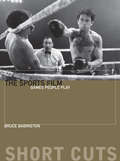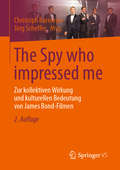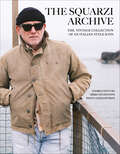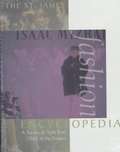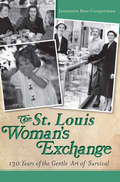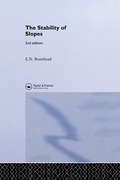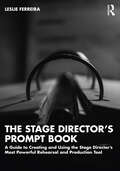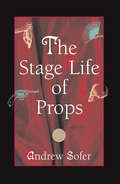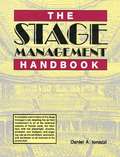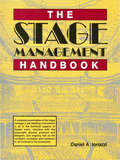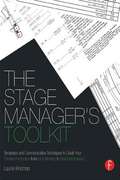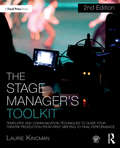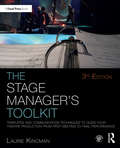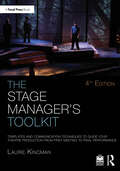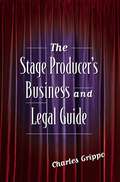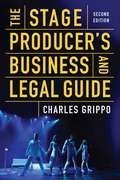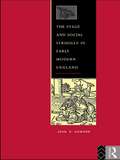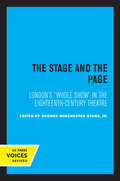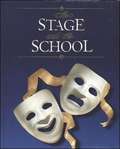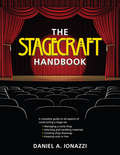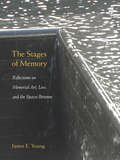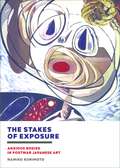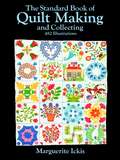- Table View
- List View
The Sports Film: Games People Play (Short Cuts)
by Bruce BabingtonAfter covering the genre's early history and theorizing its general characteristics, this volume then focuses on specific instances of sports films, such as the biopic, the sports history film, the documentary, the fan film, the boxing film, and explores issues such as gender, race, spectacle and silent comedy. Four major films are then closely analysed – Chariots of Fire, Field of Dreams, the Indian cricket epic Lagaan, and Oliver Stone's Any Given Sunday. While recording American film's importance to the genre, the book resists the conventional over-concentration on American cinema and sports by its attention to other cinemas, for example the British, Indian, Australian, South Korean, Thai, German, New Zealand, Spanish, and so on, with the many different sports they depict.
The Spy who impressed me: Zur kollektiven Wirkung und kulturellen Bedeutung von James Bond-Filmen
by Christoph Barmeyer Jörg SchefferJames Bond 007 ‒ die erfolgreichste Kinofilmserie der Welt nimmt auf seine Fangemeinde seit über 50 Jahren Einfluss: Bond zeigt den Zuschauern das Gute und Schlechte auf der Welt, repräsentiert Länder, belegt Räume mit Assoziationen und erschafft Weltbilder. Er verkörpert Ideale, Identitäten sowie einen bestimmten Stil und lebt interkulturelle Kompetenz vor. Anhand der Analyse der inhaltlichen Strukturen und Repräsentationsmuster der Filme wirft dieser Sammelband einen kritischen Blick auf die Wirkungsmacht des berühmten Geheimagenten. Für die zweite Auflage wurde der Band aktualisiert und Bezüge zum neuesten, dem 25. James-Bond-Film hergestellt.
The Squarzi Archive: The Vintage Collection of an Italian Fashion Icon
by Andrea Ventura Mirko di GiovanniA visual showcase of fashion icon Alessandro Squarzi's 6000-piece American vintage collection of rare garments spanning military to workwear, embodying styles from the '20s to the '80s with an Italian touch. The Squarzi Archive unveils Alessandro Squarzi's vast American vintage collection—a treasure from the distinguished Italian design icon and world-renowned fashion influencer. Collecting rare garments from global locales, Squarzi shares this inestimable collection, spanning military to workwear, athletic to western wear. Key features include: Global Influence: Rare '80s garments from worldwide sources showcase Squarzi's impact on American vintage fashion. Decades of Inspiration: Reflecting styles from the '20s to the '80s, the collection offers a comprehensive view of fashion evolution. Sartorial Routine: Delve into Squarzi's creative process and daily routine, emphasizing his crafting of American heritage outfits with an "Italian" touch. From Automotive Brawn to Equestrian Elegance: Experience Squarzi's unique style, transitioning effortlessly from vintage Porsche rides to elegant horse-riding expressions of style. This narrative surpasses a mere collection, providing a comprehensive look into Squarzi's creative process, blending American vintage with an Italian flair.
The St. James Fashion Encyclopedia: A Survey of Style from 1945 to the Present
by Richard MartinThe St. James Fashion Encyclopedia is a collection of well-organized and information-intensive essays (complete with biographical facts) on more than 200 designers, providing a more reliable critical measure and a larger perspective than previously available.
The St. Louis Woman's Exchange: 130 Years of the Gentle Art of Survival
by Jeannette Batz CoopermanOn the surface, the Woman's Exchange of St. Louis is an exquisite gift shop with an adjacent tearoom--beloved, always packed, the chatter light and feminine, the salads and pies perfect. But the volunteers who run the Woman's Exchange have had enough grit to keep the place going through two world wars, a Great Depression, several recessions, the end of fine craftsmanship and the start of a new DIY movement. The "decayed gentlewomen" they set out to help in 1883 are now refugees from Afghanistan, battered wives and mothers of sons paralyzed in Iraq. Sample the radical changes they have made over the years, as well as the institutions they wisely left alone, like the iconic cherry dress that has charmed generations of women and mothers, including Jacqueline Kennedy and Gwyneth Paltrow.
The Stability of Slopes
by Eddie BromheadThe new edition of this successful book has been thoroughly revised to take account of recent advances in our understanding of slope stability and instability.
The Stage Director’s Prompt Book: A Guide to Creating and Using the Stage Director’s Most Powerful Rehearsal and Production Tool
by Leslie FerreiraThe Stage Director’s Prompt Book is a step-by-step, detailed guide on how to create a practical and powerful rehearsal and performance tool—the director’s prompt book. A prompt book is a coordinating and organizational tool for the stage director. This book systematizes the creative process the director uses to analyze and interpret a play and coordinates all director-related rehearsal and production activities into a single, self-contained interpretive and organizational system. This book guides the director through the necessary steps and stages of creating and using a prompt book—from play analysis and interpretation, through the formation of a dynamic and theatrical director’s vision, to a unique method of physicalizing a play in production. A prompt book of a one-act play is included in the book as a complete example of the system. Such techniques as redlining, color coding and creating a three-column left-hand page are vividly illustrated for readers, allowing them to assemble their own prompt books. In a clear and example-driven format, The Stage Director’s Prompt Book offers a system of directorial interpretation that takes the director through a series of point-by point instructions to construct a strong, effective and creative instrument for success. For the undergraduate and graduate student of theatre directing, stage management and producing courses, along with aspiring professional directors, this book provides an interactive and intuitive approach to personalize the stage directing experience and assemble a graphically dynamic and creative director’s prompt book.
The Stage Life of Props
by Andrew SoferInThe Stage Life of Props,Andrew Sofer aims to restore to certain props the performance dimensions that literary critics are trained not to see, then to show that these props are not just accessories, but time machines of the theater. Using case studies that explore the Eucharistic wafer on the medieval stage, the bloody handkerchief on the Elizabethan stage, the skull on the Jacobean stage, the fan on the Restoration and early eighteenth-century stage, and the gun on the modern stage, Andrew Sofer reveals how stage props repeatedly thwart dramatic convention and reinvigorate theatrical practice. While the focus is on specific objects, Sofer also gives us a sweeping history of half a millennium of stage history as seen through the device of the prop, revealing that as material ghosts, stage props are a way for playwrights to animate stage action, question theatrical practice, and revitalize dramatic form. Andrew Sofer is Assistant Professor of English, Boston College. He was previously a stage director.
The Stage Lives of Animals: Zooesis and Performance (Routledge Studies in Theatre, Ecology, and Performance)
by Una ChaudhuriThe Stage Lives of Animals examines what it might mean to make theatre beyond the human. In this stunning collection of essays, Una Chaudhuri engages with the alternative modes of thinking, feeling, and making art offered by animals and animality, bringing insights from theatre practice and theory to animal studies as well as exploring what animal studies can bring to the study of theatre and performance. As our planet lives through what scientists call "the sixth extinction," and we become ever more aware of our relationships to other species, Chaudhuri takes a highly original look at the "animal imagination" of well-known plays, performances and creative projects, including works by: Caryl Churchill Rachel Rosenthal Marina Zurkow Edward Albee Tennesee Williams Eugene Ionesco Covering over a decade of explorations, a wide range of writers, and many urgent topics, this volume demonstrates that an interspecies imagination deeply structures modern western drama.
The Stage Management Handbook
by Daniel A. IonazziA complete examination of the stage manager's job, explaining the manager's involvement with all aspects of theater work including interfacing with the playwright, director, producer and designer.
The Stage Management Handbook
by Daniel A. IonazziThe stage manager is the renaissance man of the theater. He or she must have a working knowledge of how the various technical aspects of the theater work (scenery, props, costumes, lights and sound), be part director, part playwright, part designer and part producer, and be prepared to act as confidant, counselor and confessor to everyone else in the company. This book addresses all of these considerations in detail and offers the reader–professional or amateur, veteran or beginner–helpful guidance and practical advice, supported by many forms and examples to illustrate the points covered in the text. The three phrases of mounting and performing a show are covered. Part I takes the reader through the pre-production phase–research, the script, planning and organization, and auditions. Part II covers the rehearsal process–rehearsal rules, blocking, cues, prompting, information distribution, technical and dress rehearsals. Part III discusses the performance phase–calling the show, maintaining the director's work, working with understudies and replacements, and more. Part IV provides insights into the organizational structure or some theaters and aspects of human behavior in those organizations. Many stage managers of long-running commercial productions believe that–once the show is up and running–only ten percent of their work is related to everything covered in Parts I, II and III. The other ninety percent is associated with issues in Part IV; i.e. "managing" human behavior and maintaining working relationships.
The Stage Manager's Toolkit
by Laurie KincmanAs a Stage Manager, you are responsible for organizing rehearsals, running performances, and keeping everyone and everything on track and in sync. To do the job well, you need to be a communication wizard--able to collect a wide range of details and share them as effectively as possible. The Stage Manger's Toolkit is more than another overview book which generalizes how to be a Stage Manager. It presents the day-to-day duties in detail--discussing not only what to do but also why. Focusing on communication best practices, the book explores objectives, paperwork, and the questions that need to be asked in order to ensure a smooth production whether on Broadway, at a university, or somewhere in between. Introduces strategies for sharing information both in person and in writing Explores how document design can enhance the accessibility and effectiveness of your reports, charts, and lists Contains principles for web-based information sharing as well as hard-copy paperwork Provides customizable paperwork templates on the accompanying website, allowing you to put the ideas to work on your own show Other features: Organized based on the chronology of a typical theatre production: pre-production work, rehearsals, the tech period, performances, and post-production duties. In each section, the book outlines the objectives for the stage manager and the communication techniques that will ensure success. Provides examples of paperwork a stage manager commonly works with, including variations for plays and musicals, shortcuts for shows on an abbreviated time table, and strategies for maintaining consistency and legibility. The book highlights differences the stage manager may encounter when working on professional and academic productions.
The Stage Manager's Toolkit: Templates and Communication Techniques to Guide Your Theatre Production from First Meeting to Final Performance (The Focal Press Toolkit Series)
by Laurie KincmanThe Stage Manager’s Toolkit provides a comprehensive account of the role of the stage manager for live theatre with a focus on both written and verbal communication best practices. The book outlines the duties of the stage manager and assistant stage manager throughout a production, discussing not only what to do but why. The book identifies communication objectives for each phase of production, paperwork to be created, and the necessary questions to be answered in order to ensure success.
The Stage Manager's Toolkit: Templates and Communication Techniques to Guide Your Theatre Production from First Meeting to Final Performance (The Focal Press Toolkit Series)
by Laurie KincmanThe Stage Manager’s Toolkit, Third Edition provides a comprehensive account of the role of the stage manager for live theatre with a focus on both written and verbal communication best practices. The book outlines the duties of the stage manager and assistant stage manager throughout a production, discussing not only what to do but why. It also identifies communication objectives for each phase of production, paperwork to be created, and the necessary questions to be answered in order to ensure success. This third edition includes: an updated look at digital stage management tools including script apps, cloud storage, and social media practices; a new discussion on creating a healthy and safe rehearsal space; updated paperwork examples; new information on Equity practices for the student and early career stage managers. Written for the stage management student and early career stage manager, this book is a perfect companion to any university Stage Management course. A companion website hosts customizable paperwork templates, instructional video, links to additional information, teacher tools for each individual chapter, and a bonus chapter on teaching stage management.
The Stage Manager's Toolkit: Templates and Communication Techniques to Guide Your Theatre Production from First Meeting to Final Performance (The Focal Press Toolkit Series)
by Laurie KincmanThe Stage Manager’s Toolkit, Fourth Edition, provides a comprehensive account of the role of the stage manager for live theatre with a focus on both written and verbal communication best practices.The book outlines the duties of the stage manager and assistant stage manager throughout a production, discussing not only what to do but why. It also identifies communication objectives for each phase of production, paperwork to be created, and the necessary questions to be answered to ensure success. This fourth edition includes: a new chapter devoted to documenting movement which includes both intimacy choreography and stage combat; updated and expanded information on using technology and social media; expanded information on the digital prompt book and other digital and web-based tools; updated paperwork examples; more information on Equity practices for the student and early career stage managers. Written for the stage management student and early career stage manager, this book is a perfect addition to any university Stage Management course.A companion website hosts customizable paperwork templates, instructional videos, links to additional information, teacher tools for individual chapters, and a bonus section on teaching stage management. To access these resources, visit www.routledge.com/cw/kincman.
The Stage Producer's Business and Legal Guide
by Charles GrippoThe entire range of individuals involved in entertainment-performers, writers, and directors to box office managers, theater board members, and theater owners-will find comprehensive answers to questions on every aspect of theater business and law. Written by attorney, producer, and playwright, this book reveals hundreds of insider strategies for minimizing legal costs, negotiating contracts, and licensing and producing plays. It also features expert, practical advice on such topics as tax risks and liabilities, safety regulations, organizing the theater company, financing, box office management, not-for-profit management, and much more. Plus everything is explained clearly, written without a lot of legal jargon.
The Stage Producer's Business and Legal Guide (Second Edition)
by Charles GrippoExpert, Practical Advice for Everyone in Show Business Now updated and expanded, this second edition of The Stage Producer’s Business and Legal Guide is the ultimate survival kit for anyone presenting live entertainment. The information contained in this handbook is essential for those working in Broadway, regional, stock, or university theater; concert halls; opera houses; and more. Attorney, producer, and playwright Charles Grippo provides comprehensive advice on every aspect of the theater business and the law, including: Crowdfunding Your ProductionNew Opportunities to Raise MoneySelf-ProductionLicensing and Producing PlaysDevised Theater and CollaborationsCreating Jukebox MusicalsOrganizing a Theater CompanyTheatrical InsuranceMaintaining a Harassment-Free EnvironmentNegotiating ContractsEssential Rules Every Board Member Must KnowManaging a Not-for-Profit Theater CompanyNavigating TaxesUsing Third-Party Intellectual PropertyAnd much, much more! The entire range of individuals involved in entertainment—producers, performers, writers, directors, managers, and theater owners—will find invaluable practical and legal advice in this handy guide.
The Stage and Social Struggle in Early Modern England
by Jean E. HowardThe Stage and Social Struggle in Early Modern England is a ground-breaking study of a controversial period of English literary, cultural, and political history. In language that is both lucid and theoretically sophisticated, Jean Howard examines the social and cultural facets of early modern theatre. She looks at the ways in which some theatrical practices were deemed deceptive and unreliable, while others were lent legitimacy by the powerful. An exciting and challenging work by one of the leading writers in the field, The Stage and Social Conflict in Early Modern England is important reading for anyone interested in the period.
The Stage and the Page: London's Whole Show in the Eighteenth-Century Theatre (Clark Library Professorship, UCLA #6)
by Geo. Winchester StoneThis title is part of UC Press's Voices Revived program, which commemorates University of California Press’s mission to seek out and cultivate the brightest minds and give them voice, reach, and impact. Drawing on a backlist dating to 1893, Voices Revived makes high-quality, peer-reviewed scholarship accessible once again using print-on-demand technology. This title was originally published in 1981.
The Stage and the School
by Harry H. Schanker Katharine Anne OmmanneyThe Stage and the School offers more of what you've always loved about the nation's most comprehensive high school drama program. More hands-on exercises. More teacher support. More discussion of the conventions of the theatre. More opportunities to creative expression through performance. More connections to the other arts. With all the hands-on exercises and application activities, scenes and monologues, chapter openers and reviews, students are provided with every opportunity for success.
The Stagecraft Handbook
by Daniel IonazziGet the complete, illustrated guide to scenery construction Using nails and wood, fabric and paint, hardware and rigging, you create an illusion. You build the make-believe world of the play. Now you have a scene-shop manual to help you. In The Stagecraft Handbook, Daniel A. Ionazzi, director of production for the UCLA Department of Theater, offers trap-room-to-grid guidance. Clearly written, heavily illustrated, this book covers every aspect of scenery construction. Turn here and learn about: the four primary stage configurations–proscenium, thrust, arena and environmental flying scenery and moving floors organizing the scene shop to make good scenery quickly and inexpensively shop tools and safety scaled drawings, models and other communications tools you'll use to translate the designer's vision into a set materials commonly used in building scenery construction techniques for flats, platforms and other standard scenic units installing and rigging scenery maintaining an inventory of stock scenery Let The Stagecraft Handbook help you turn ordinary materials into extraordinary illusions.
The Stages of Memory: Reflections on Memorial Art, Loss, and the Spaces Between (Public History In Historical Perspective Ser.)
by James E. YoungFrom around the world, whether for New York City’s 9/11 Memorial, at exhibits devoted to the arts of Holocaust memory, or throughout Norway’s memorial process for the murders at Utøya, James E. Young has been called on to help guide the grief stricken and survivors in how to mark their losses. This poignant, beautifully written collection of essays offers personal and professional considerations of what Young calls the “stages of memory,” acts of commemoration that include spontaneous memorials of flowers and candles as well as permanent structures integrated into sites of tragedy. As he traces an arc of memorial forms that spans continents and decades, Young returns to the questions that preoccupy survivors, architects, artists, and writers: How to articulate a void without filling it in? How to formalize irreparable loss without seeming to repair it? Richly illustrated, the volume is essential reading for those engaged in the processes of public memory and commemoration and for readers concerned about how we remember terrible losses.
The Stakes of Exposure: Anxious Bodies in Postwar Japanese Art
by Namiko KunimotoHow would artistic practice contribute to political change in post–World War II Japan? How could artists negotiate the imbalanced global dynamics of the art world and also maintain a sense of aesthetic and political authenticity? While the contemporary art world has recently come to embrace some of Japan&’s most daring postwar artists, the interplay of art and politics remains poorly understood in the Americas and Europe. The Stakes of Exposure fills this gap and explores art, visual culture, and politics in postwar Japan from the 1950s to the 1970s, paying special attention to how anxiety and confusion surrounding Japan&’s new democracy manifested in representations of gender and nationhood in modern art. Through such pivotal postwar episodes as the Minamata Disaster, the Lucky Dragon Incident, the budding antinuclear movement, and the ANPO protests of the 1960s, The Stakes of Exposure examines a wide range of issues addressed by the period&’s prominent artists, including Tanaka Atsuko and Shiraga Kazuo (key members of the Gutai Art Association), Katsura Yuki, and Nakamura Hiroshi. Through a close study of their paintings, illustrations, and assemblage and performance art, Namiko Kunimoto reveals that, despite dissimilar aesthetic approaches and divergent political interests, Japanese postwar artists were invested in the entangled issues of gender and nationhood that were redefining Japan and its role in the world. Offering many full-color illustrations of previously unpublished art and photographs, as well as period manga, The Stakes of Exposure shows how contention over Japan&’s new democracy was expressed, disavowed, and reimagined through representations of the gendered body.
The Standard Book of Quilt Making and Collecting
by Marguerite IckisHere is the best available book on quilt making -- a complete, easy-to-follow guide that shows you how to make beautiful, useful quilts that you will be proud to own and display. Even if you are a beginner, you will soon find yourself quilting like an expert by following these clearly drawn patterns, photographs, and step-by-step instructions.All the information you need is here, lucidly and thoroughly explained. You'll learn how to plan the quilt, the number of blocks to fit a bed, how to select the pattern to harmonize with the design and color of the room, and how to choose materials. Clear directions explain how to cut, sew, and make applique patterns, patchwork, and strips. An entire chapter on design discusses basic elements, sources, making your own designs, avoiding sewing problems, how to use the rag bag, and much more. The section on patterns gives directions on tracing, seam allowance, and estimating quantity. There is full information on borders, quilting, and tufting, and just about every other aspect of quilt making.Mrs. Ickis shows you over 100 traditional and unusual quilts, including Basket, Tree of Life, Flowers in a Pot, Traditional Geometric, Friendship, Square and Cross, Saw Tooth, Drunkard's Path, Flying Geese, Mexican Cross, Pennsylvania Dutch, Crazy Quilts, Yo-yo Quilts, Album Quilts, and dozens of others, including over 40 full-size patterns. You are given other uses for quilting, such as drapes, curtains, upholstery, lunch cloths, purses, cushions, and Italian quilting.Completing the coverage are fascinating chapters on collecting quilts as a hobby; how to make full-size patterns of famous American quilts from pictures, small designs, and museum or collector's quilts; and a history of quilt making with personal memories.
The Stanislavski System: The Professional Training of an Actor
by Sonia MooreAn overview of Konstantin Stanislavski and his instruction of his acting method, now known among actors simply as "the method."
